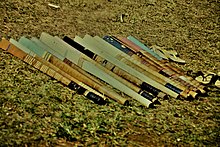Kilikiti

Kilikiti is one of several forms of the game of cricket. Originating in Samoa (English missionaries introduced their game of cricket in the early 19th century), it spread throughout Polynesia and can now be found around the world in areas with strong Polynesian populations. The game is the national sport of Samoa,[1] and is played in many other Pacific countries,[2] including amongst the Pacific Islander diaspora in New Zealand.
Form of the game[]
Equipment[]
The ball is made of a very hard rubber wrapped in pandanus. Players are not protected by any padding or masks, and will often wear only a lava-lava. The sennit-wrapped wooden bat is modeled on the three-sided Samoan war club called the "lapalapa," which are based on the stalk of coconut fronds. Bats are shaped to individual players' likings and can be over a meter long; because the striking surface of the bat is angled (just as the "lapalapa" club and the coconut frond stalk), the path of a hit ball is extremely hard to predict.[2]
Rules[]
The rules of kilikiti are flexible. Indeed, the majority of reports written on the game simply say that the rules can only be known by those playing.[2]
Similarities to cricket[]
There is a batting team, a fielding team, and a pitch (sometimes of concrete). The bowl alternates between two bowlers, one at each end of the pitch; accordingly, there are two wicket keepers (this as opposed to the single wicket keeper in cricket).
Major points on which kilikiti differs from cricket[]
There is no limit to team size, and teams are made up of whoever turns up regardless of gender or age.[3] Tourist accounts mention that strangers are often welcomed. Players are typically all-rounders. A kilikiti game is a multi-day community event full of singing, dancing, and feasting. Entire villages will compete and everyone will be involved, whether as player, cook, or spectator. (According to one source, the only universal rule is that the host team forfeits if it cannot provide enough food).[3]
Standardization[]
The New Zealand Kilikiti Association (NZKA) is working to standardize the rules of kilikiti. In 1999 the NZKA started a national tournament, called the Supercific Kilikiti Tournament, and in 2001 it introduced the international World Cup Kilikiti Tournament. Games have been cut to a television-friendly 70 minutes (2 innings, the first being 30 minutes long and the second bowling the same number of balls as the first). The NZKA has also added the scoring of 4s and 6s.
Kilikiti World Cup[]
2001[]
The first Kilikiti World Cup was held at , Henderson, Auckland, New Zealand in January 2001. Seven teams took part, representing American Samoa, Australia, the Cook Islands, New Zealand, Niue, Tokelau and the United States. The final, played over a series of three games, was won by the , who beat the two games to one.[4]
2002[]
The 2002 Kilikiti World Cup took place at , Glen Eden, Auckland, New Zealand.
2015[]
The 2015 Kilikiti World Cup took place at Frank Kitts Park, Wellington, New Zealand.
See also[]
References[]
- ^ "Samoa's version of cricket, kilikiti, on display in Melbourne tournament". ABC News.
- ^ a b c Squires, Tony (1 April 2012). "Testing time for tiny Tuvalu". BBC News. Retrieved 31 October 2012.
- ^ a b "Kirikiti - 37 for the loss of 19 wickets?". India Engineers Cricket Club Newsletter. Vol. 43. 2004-09-02. Archived from the original on 2005-02-25. Retrieved 2005-09-05.
- ^ Daniels, C., "Kilikiti: We are world's best," New Zealand Herald, 22 January 2001. Retrieved 18 November 2020.
External links[]
- New Zealand Kilikiti Association
- Simon, Liza (text); Haar, Tom (photography). "South Seas Cricket: The staid British sport gets a Polynesian makeover". Hana Hou. Archived from the original on 2005-03-26. Retrieved 2005-09-05.
- Leilua, Iulia (2005). "Supercific Kilikiti Tournament". Archived from the original on 2006-05-17. Retrieved 2005-09-05.
- "Independent Samoa: Its Culture and Atmosphere". h2g2. BBC. Retrieved 2005-09-05.
- "Cricket – Pacific Style". Museum of New Zealand Te Papa Tongarewa. Retrieved 2015-05-03.
- 2001 Kilikiti World Cup highlights on YouTube
- Short form cricket
- Cricket in Samoa
- Sports originating in Samoa
- Sport in Tuvalu